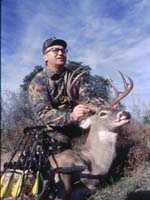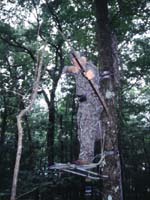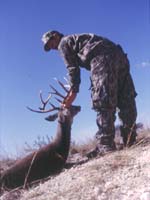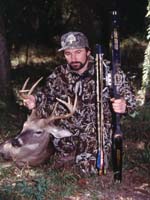
|
Features
|
|
|
|
Books
|
|
|
|
Fun & Games
|
|
|
|
Contact Us
|
|
|
John's Journal... Entry 51, Day 1
Shrinking the Woods
 Editor's
Note: Many bowhunters think of themselves as two-season hunters who hunt
with bows and arrows during bow season and then become gun hunters as
soon as gun season arrives. However, in the states that have bow season
and gun season occurring simultaneously, a sportsman may have a greater
chance of taking a trophy buck with a bow during gun season than he does
with a gun.
Editor's
Note: Many bowhunters think of themselves as two-season hunters who hunt
with bows and arrows during bow season and then become gun hunters as
soon as gun season arrives. However, in the states that have bow season
and gun season occurring simultaneously, a sportsman may have a greater
chance of taking a trophy buck with a bow during gun season than he does
with a gun.
You already understand the directly opposite philosophies of the two sports of gun hunting and bowhunting. Gun hunters use binoculars and scopes to see further and shoot deer at greater distances than bowhunters do. A rifle hunter takes great pride in making 150- to 300-yard shots on deer and will brag that, "If I can see a buck, I can bag him." Therefore you'll usually find most of the gun-hunting pressure concentrated in open places.
 However,
bowhunters want their deer in close. Bowhunters make their average bow
shots at deer at about 18 yards, with 90% of the successful shots made
at less than 30 yards. Most proficient bowhunters will hunt in thick cover
where they'll encounter the least amount of pressure from gun hunters
and find the most deer.
However,
bowhunters want their deer in close. Bowhunters make their average bow
shots at deer at about 18 yards, with 90% of the successful shots made
at less than 30 yards. Most proficient bowhunters will hunt in thick cover
where they'll encounter the least amount of pressure from gun hunters
and find the most deer.
To take deer when you bowhunt, you must use your scouting abilities well and accurately predict where and when a deer will show up within 30 yards or less of a particular tree where you've put your tree stand. But when gun hunting, you'll probably use your optics more, which will enable you to spot a deer long before the deer smell or see you. Because of the differences in these two styles of hunting, bowhunters have the odds stacked in their favor during gun season. Let's look at why.
 Besides
knowing where a deer will appear, you must understand why a buck won't
come to certain areas. The less woods you must hunt for a buck, the more
intensively you can scout, and the more you can learn about deer in the
region and their habits in a shorter time.
Besides
knowing where a deer will appear, you must understand why a buck won't
come to certain areas. The less woods you must hunt for a buck, the more
intensively you can scout, and the more you can learn about deer in the
region and their habits in a shorter time.
As Sam Spencer of Montgomery, Alabama, an avid bowhunter and a biologist, explains, "You actually kill your deer scouting; you just collect it when you're hunting."
Using an aerial photo to pinpoint creeks, drainage ditches, bald spots and cut-overs and having knowledge of the lands where most gun hunters hunt will tip the scales heavily in your favor when bowhunting. Most gun hunters won't walk more than 1/4- to 1/2-mile from any roads, which means the heaviest hunting pressure will occur within 1/4- to 1/2-mile of the road system. An aerial photo will allow you to pinpoint the places with the most hunting pressure. Eliminate these close-to-the road areas from your hunt plan.
Gun hunters usually will concentrate most of their hunting time in places where they can see the longest distances. You can cross off right-of-ways and open woods from your list as regions you don't need to bowhunt, since you know gun hunters will frequent these spots. But anyone gun hunting will seldom appear in thick cover where he can see less than 30 yards. Yet you'll find these spots ideal bowhunting sites, because that's the precise range a bowhunter needs to make an accurate shot.
 Having
eliminated the parts of the woods where gun hunters most likely will hunt
and you'll find the highest hunting pressure, you now will have an accurate
picture on your aerial photo of where the fewest gun hunters but the most
deer will appear.
Having
eliminated the parts of the woods where gun hunters most likely will hunt
and you'll find the highest hunting pressure, you now will have an accurate
picture on your aerial photo of where the fewest gun hunters but the most
deer will appear.
Check back each day this week for more about Bowhunters Have The Edge For Big Bucks ...
Day 1 -Shrinking the Woods
Day 2 -Scouting Thick Cover
Day 3 -Letting the Gun Hunter Drive the Bucks
to You
Day 4 -Determining the Best Times to Bowhunt
During Gun Season
Day 5 -Learning the Best Days to Bag a Trophy
Buck During Gun Season